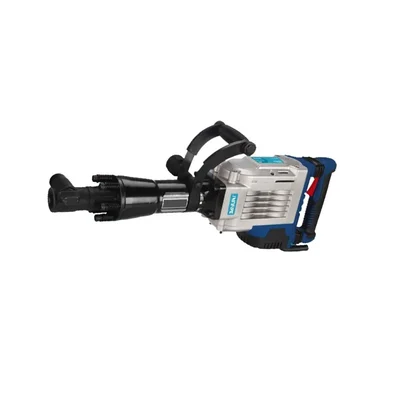- Farm & Garden
- Pumps & Motors
- Food Processing
- Workshop, DIY & MRO

Brand: DAYURI
Dayuri 20 Kg 2200 W, 60 J Impact Energy Demolition Hammer, 1900 BPM Heavy Duty Concrete Breaker Tool (DA5053)
SKU: TI-D2-27462
 1083 people have viewed this recently
1083 people have viewed this recently  Delivery By: Dec 18 - Dec 20
Delivery By: Dec 18 - Dec 20 





MRP : ₹21450 ₹17183
20% OFF!

 1083 people have viewed this recently
1083 people have viewed this recently  Delivery By: Dec 18 - Dec 20
Delivery By: Dec 18 - Dec 20 

Easy Return
& Refund
& Refund

Quality
Assurance
Assurance

Trusted
Delivery
Delivery

After Sales
Assistance
Assistance

Buyer
Protection
Protection
₹17183 (Including GST)
MRP : ₹21450
20% OFF!
Get Extra ₹258 OFF on Prepaid Orders
QTY :
-
1
+
Short Description
- DAYURI 21 kg 2200 W Demolition Hammer
- 1900 BPM
- 60 J Impact Energy
Country of origin: China
Specifications
- Brand: DAYURI
- Power : 2200 w
- Weight (Approx.) : 20 kg
- Max. Impact Rate : 1900 bpm
- Model No : DA5053
- Type : Demolition Hammer
- Impact Energy : 60 Joules
- No Load Speed : 1900 BPM (Blows Per Minute)
- Rated Voltage : 230 V
- Rated Frequency : 50/60 Hz
- Shank Type : HEX
Description
The Dayuri DA5053 Demolition Hammer delivers 60J of impact energy at 1900 BPM, powered by a robust 2200W motor. Weighing 20kg, it's ideal for tough demolition tasks in concrete and masonry. Designed for professional use, it ensures efficiency, durability, and power. Built in India for demanding construction jobs.
Features
:- High 60 Joules of impact energy for intense demolition
- Powerful 2200W motor for demanding tasks
- 1900 blows per minute for efficient concrete breaking
- Heavy-duty 20 kg build for maximum impact force
- Hex shank system for secure and easy chisel changes
- Ergonomic design minimizes user fatigue
- Durable construction built for job site reliability
- Ideal for demolition, concrete, and masonry applications
- Made in India with industrial-grade components
Applications
:Demolition hammers are power tools used to break down hard materials like concrete, masonry, and tile flooring. They are essential for construction and renovation projects, and can be used for a variety of tasks, including:
- Concrete Breaking : Ideal for breaking reinforced concrete slabs, floors, and walls.
- Masonry Demolition : Efficiently demolishes bricks, stone, and masonry structures.
- Roadwork & Pavement Removal : Used in breaking asphalt, pavement, and road surfaces.
- Construction & Renovation : Suitable for structural modifications, wall removal, and floor breaking in construction and renovation projects.
- Chiseling Work : Great for heavy chiseling tasks such as tile removal, foundation work, and trenching.
- Industrial Demolition : Performs well in industrial demolition jobs that require high impact force and reliability.
- Heavy-Duty Site Work : Used by professionals for demanding demolition operations on construction sites.
Usage
:User Instructions :
1. Safety First
- Wear Protective Gear: Always use safety goggles, ear protection, gloves, dust mask, and steel-toe boots.
- Check the Area: Make sure the area is clear of hazards like live wires, gas lines, or water pipes.
- Inspect the Tool: Check the power cord, chisel/bit, and body for any damage before use.
2. Choose and Insert the Correct Chisel
- Select the appropriate HEX shank chisel for the job (pointed, flat, wide, etc.).
- Insert the chisel into the hex socket until it clicks and locks securely.
- Pull slightly on the bit to confirm it’s locked in place.
3. Plug In the Tool
- Connect the demolition hammer to a 230V power source.
- Ensure the extension cord (if used) is heavy-duty and suitable for construction tools.
4. Hold the Tool Properly
- Use both hands on the handles for maximum control and stability.
- Maintain a firm grip and balanced stance before starting.
5. Power On and Begin Work
- Switch on the tool.
- Let the hammer reach full speed (1900 BPM) before pressing it against the surface.
- Do not force the tool—let the 60J impact energy do the work.
- Apply steady pressure and guide the chisel along the area to be broken.
6. Take Breaks to Avoid Overheating
- For long-duration use, take breaks to prevent overheating the motor.
- Let the tool cool down if you notice reduced performance.
7. After Use
- Switch off the tool and unplug it.
- Remove the chisel after it cools down.
- Clean the tool and store it in a dry, dust-free place.
Maintenance :
1. Daily Maintenance (After Each Use) :
- Clean the Tool : Wipe off dust, concrete debris, and moisture with a dry cloth. Use compressed air to clean vents and moving parts.
- Inspect Power Cord & Plug : Check for cuts, frays, or damage. Replace damaged cords immediately to prevent electric shock.
- Check Chisel/Bit : Remove and inspect the chisel for wear or deformation. Replace if the tip is dull or cracked.
2. Weekly Maintenance :
- Inspect the Carbon Brushes : If the motor power seems weak or sparks excessively, check carbon brushes. Replace when worn to less than 50% of original length.
- Lubricate Moving Parts : Apply appropriate grease to the tool’s mechanical components (refer to user manual or manufacturer’s recommendation).
Important : Do not over-grease, and avoid grease on electrical parts.
3. Monthly Maintenance :
Check Bolts & Screws : Tighten any loose fasteners to prevent vibration-related damage.
Inspect Impact Mechanism : If performance decreases or strange noises occur, have a technician inspect the internal hammering mechanism.
Motor Vent Cleaning : Clear ventilation slots of dust buildup to prevent overheating and ensure proper airflow.
4. Long-Term Maintenance :
- Full Service Every 6 Months or After Heavy Use : Take the tool to an authorized service center for deep inspection and servicing of motor, gears, and impact mechanism.

Select attribute








